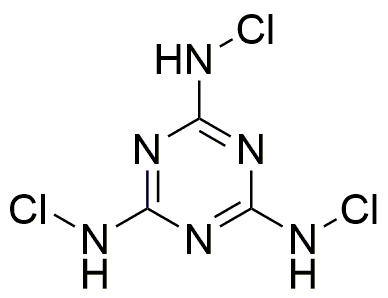Trichloromelamine is widely utilized in research focused on:
- Water Treatment: It is effective as a disinfectant in water purification processes, helping to eliminate harmful microorganisms and ensure safe drinking water.
- Textile Industry: Used as a flame retardant, it enhances the fire resistance of fabrics, making it a valuable additive in the production of protective clothing and upholstery.
- Pharmaceuticals: Its antimicrobial properties make it useful in formulating antiseptic agents, contributing to the development of medical products that prevent infections.
- Agriculture: Employed as a biocide, it helps in controlling pests and diseases in crops, promoting healthier yields and reducing the need for more harmful chemicals.
- Laboratory Reagents: Commonly used in chemical synthesis and analytical chemistry, it serves as a reagent in various reactions, aiding researchers in their experiments and studies.
General Information
Properties
Safety and Regulations
Applications
Trichloromelamine is widely utilized in research focused on:
- Water Treatment: It is effective as a disinfectant in water purification processes, helping to eliminate harmful microorganisms and ensure safe drinking water.
- Textile Industry: Used as a flame retardant, it enhances the fire resistance of fabrics, making it a valuable additive in the production of protective clothing and upholstery.
- Pharmaceuticals: Its antimicrobial properties make it useful in formulating antiseptic agents, contributing to the development of medical products that prevent infections.
- Agriculture: Employed as a biocide, it helps in controlling pests and diseases in crops, promoting healthier yields and reducing the need for more harmful chemicals.
- Laboratory Reagents: Commonly used in chemical synthesis and analytical chemistry, it serves as a reagent in various reactions, aiding researchers in their experiments and studies.
Documents
Safety Data Sheets (SDS)
The SDS provides comprehensive safety information on handling, storage, and disposal of the product.
Product Specification (PS)
The PS provides a comprehensive breakdown of the product’s properties, including chemical composition, physical state, purity, and storage requirements. It also details acceptable quality ranges and the product's intended applications.
Certificates of Analysis (COA)
Search for Certificates of Analysis (COA) by entering the products Lot Number. Lot and Batch Numbers can be found on a product’s label following the words ‘Lot’ or ‘Batch’.
*Catalog Number
*Lot Number
Certificates Of Origin (COO)
This COO confirms the country where the product was manufactured, and also details the materials and components used in it and whether it is derived from natural, synthetic, or other specific sources. This certificate may be required for customs, trade, and regulatory compliance.
*Catalog Number
*Lot Number
Safety Data Sheets (SDS)
The SDS provides comprehensive safety information on handling, storage, and disposal of the product.
DownloadProduct Specification (PS)
The PS provides a comprehensive breakdown of the product’s properties, including chemical composition, physical state, purity, and storage requirements. It also details acceptable quality ranges and the product's intended applications.
DownloadCertificates of Analysis (COA)
Search for Certificates of Analysis (COA) by entering the products Lot Number. Lot and Batch Numbers can be found on a product’s label following the words ‘Lot’ or ‘Batch’.
*Catalog Number
*Lot Number
Certificates Of Origin (COO)
This COO confirms the country where the product was manufactured, and also details the materials and components used in it and whether it is derived from natural, synthetic, or other specific sources. This certificate may be required for customs, trade, and regulatory compliance.


